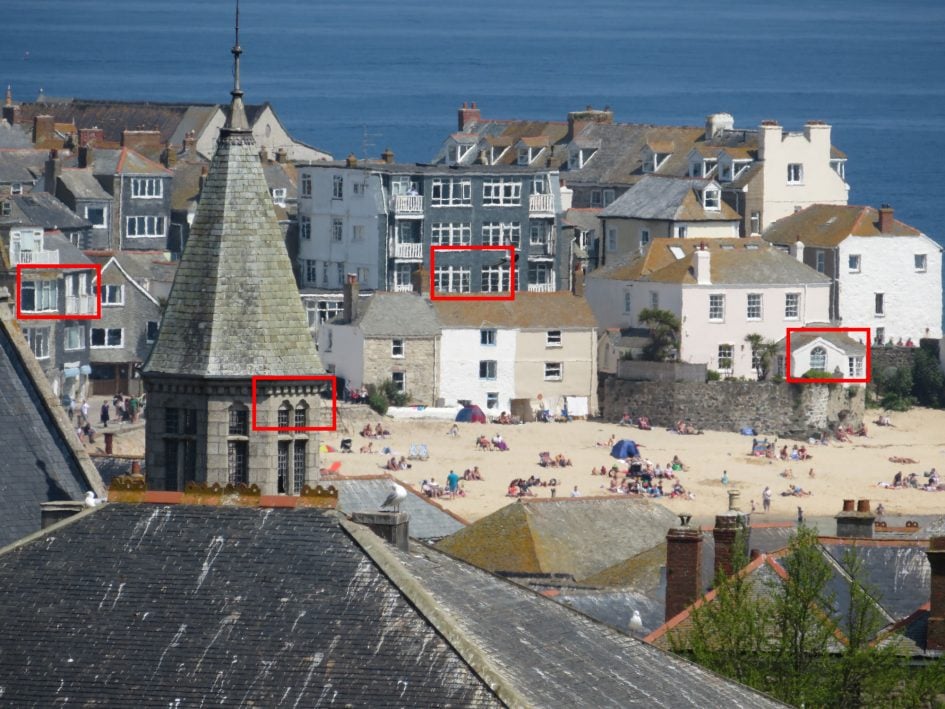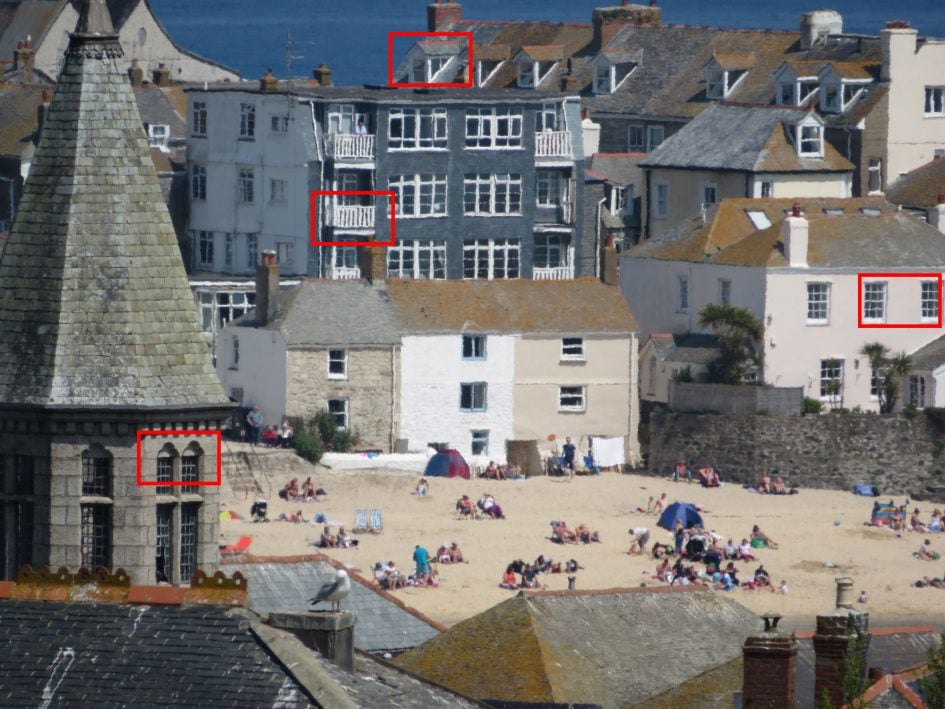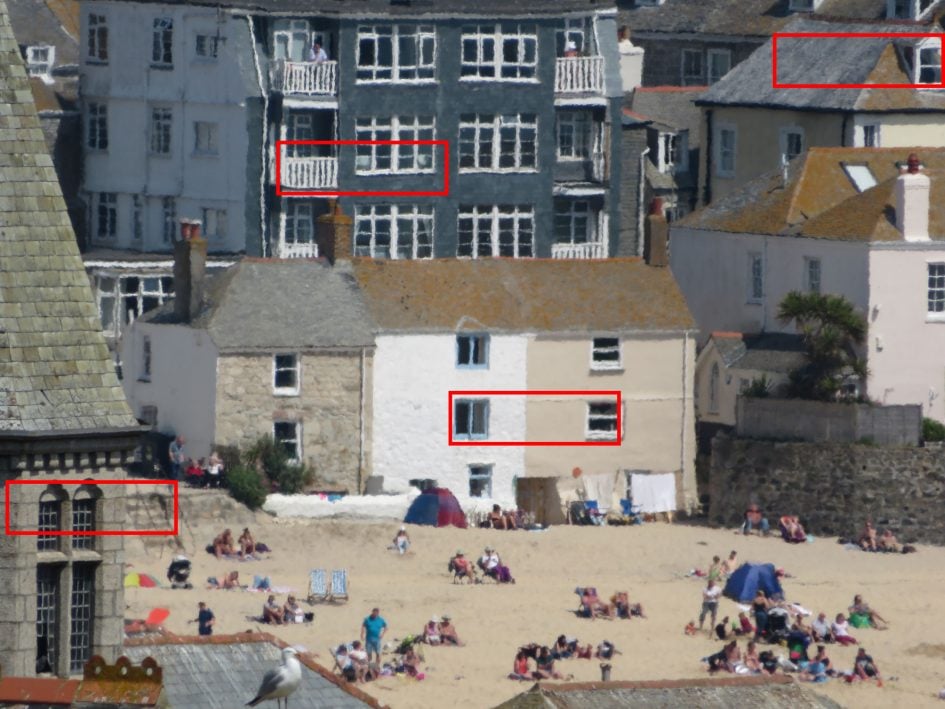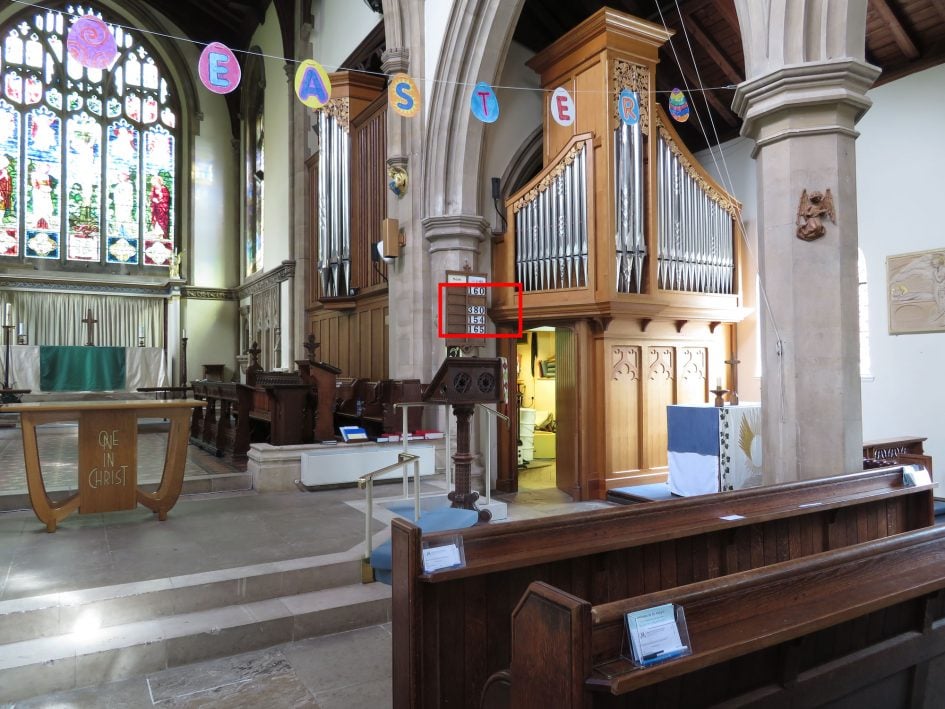Canon SX720 HS review
-
-
Written by Ken McMahon
Quality
Canon PowerShot SX720 HS vs Panasonic Lumix TZ80 / ZS60 quality
To test real-life performance, I shot this scene with the Canon PowerShot SX720 HS and the Panasonic Lumix TZ80 / ZS60 using their best quality JPEG settings and at their base 80 ISO sensitivity setting. Both cameras were mounted on a tripod and image stabilisation was disabled, the sensitivity was manually set to 80 ISO and Aperture priority mode was selected for the exposure. I’d previously determined that the SX720 HS produced equally good results at f3.3 and f4 and shot comparisons at both apertures. Here I’ve used the f3.3 results as they were more consistent in terms of exposure. At f3.3 both cameras selected a shutter speed of 1/1250.
The first table below shows the PowerShot SX720 HS at its maximum 24mm equivalent wide angle setting with, as I’ve said, the aperture set to f3.3. The crops are taken from across the frame with the first and last from close to the left and right edges with the crops two and three closer to the middle of the frame as you can see marked by the red frames above. The SX720 HS gets off to a poor start with a crop from the left edge of the frame which is, there’s no other way to describe it, pretty blurry.
The second and third crops from closer to the middle of the frame show a marked improvement though. Here there’s a lot more detail with sharp clean edges, but even in the centre, where the lens produces its best results, the sensor struggles to resolve the finer detail. You can’t make out the structure of the stonework on the church tower, or the time on the clock, nor can you see the individual roof tiles on the buildings in the foreground of the second crop. The distant lighthouse in the third crop is obscured by atmospheric haze, but the one in the foreground at the bottom is quite crisp and well defined.
The final crop from close to the right edge of the frame is much clearer than the one on the left and you can make out a good level of detail in the roofs and chimneys.
The comparison with the Lumix TZ80 / ZS60 is an interesting one. The first Panasonic crop is much better than the Canon one, but from there onwards the PowerShot SX720 HS is in front all the way with sharper crops showing more detail than those from the Lumix TZ80 / ZS60. With 20 Megapixels the Canon sensor produces slightly larger image detail, but there’s more of it and it’s sharper too.
Scroll down the page to see more quality comparisons at a range of longer focal lengths, or to find out how it performs at higher sensitivities head for my Canon SX720 HS noise results, skip to my Canon SX720 HS sample images, or head straight to my verdict.

Above left: Canon PowerShot SX720 HS at 4.3mm (24mm equivalent) f3.3, 80 ISO. Above right: Panasonic Lumix TZ80 / ZS60 at 4.3mm (24mm equivalent) f3.3, 80 ISO.

Above left: Canon PowerShot SX720 HS at 4.3mm (24mm equivalent) f3.3, 80 ISO. Above right: Panasonic Lumix TZ80 / ZS60 at 4.3mm (24mm equivalent) f3.3, 80 ISO.

Above left: Canon PowerShot SX720 HS at 4.3mm (24mm equivalent) f3.3, 80 ISO. Above right: Panasonic Lumix TZ80 / ZS60 at 4.3mm (24mm equivalent) f3.3, 80 ISO.

Above left: Canon PowerShot SX720 HS at 4.3mm (24mm equivalent) f3.3, 80 ISO. Above right: Panasonic Lumix TZ80 / ZS60 at 4.3mm (24mm equivalent) f3.3, 80 ISO.
Canon PowerShot SX720 HS quality at 450mm equivalent

The image above was taken with the PowerShot SX720 HS at roughly 450mm equivalent. As the lens is zoomed in, the maximum aperture closes. At each focal length tested I set the aperture to the maximum available – in this case f5.6 on the PowerShot SX720 HS and f6 on the Lumix TZ80 / ZS60. As before the cameras were mounted on a tripod and stabilisation disabled. The crops are taken from the areas marked in red.
At 450mm equivalent you’ll notice that there’s a lot of what looks like distortion with lines that should be straight – the edges of window frames for example – looking wobbly. This is due in part to atmospheric conditions and the varying refractive properties of the air between the subject and the camera lens. But given these test images were taken at the same time under the same conditions we can still make valid comparisons. Where, with the exception of the first crop, the PowerShot SX720 HS had a clear advantage at the 24mm equivalent focal length, here in the middle of the zoom range I don’t think there’s very much in it at all.

Above left: Canon PowerShot SX720 HS at 81mm (452mm equivalent) f5.6, 80 ISO. Above right: Panasonic Lumix TZ80 / ZS60 at 83.4mm (456mm equivalent) f6, 80 ISO.

Above left: Canon PowerShot SX720 HS at 81mm (452mm equivalent) f5.6, 80 ISO. Above right: Panasonic Lumix TZ80 / ZS60 at 83.4mm (456mm equivalent) f6, 80 ISO.

Above left: Canon PowerShot SX720 HS at 81mm (452mm equivalent) f5.6, 80 ISO. Above right: Panasonic Lumix TZ80 / ZS60 at 83.4mm (456mm equivalent) f6, 80 ISO.

Above left: Canon PowerShot SX720 HS at 81mm (452mm equivalent) f5.6, 80 ISO. Above right: Panasonic Lumix TZ80 / ZS60 at 83.4mm (456mm equivalent) f6, 80 ISO.

For this next set of crops I zoomed The TZ100 / ZS100 in to it’s maximum 720mm equivalent focal length and matched it on the PowerShot SX720 HS. As before the crops are taken from the red areas shown above. Here I think it is possible to see a quality difference between the two sets of crops and this time it’s the Lumix TZ80 / ZS60 which wins it. There’s clearly more detail in the stonework in the first crop and all of the others look just a little bit sharper and more detailed.
Again the major limiting factor in the quality here is the impact of heat rising so it’s important to remember if you are going for a super-zoom camera, you may suffer a similar effect that becomes more pronounced the longer you zoom. This may limit the usefulness of a super-zoom range, at least when shooting distant landscape compositions.

Above left: Canon PowerShot SX720 HS at 123mm (686mm equivalent) f5.6, 80 ISO. Above right: Panasonic Lumix TZ80 / ZS60 at 129mm (720mm equivalent) f6, 80 ISO.

Above left: Canon PowerShot SX720 HS at 123mm (686mm equivalent) f5.6, 80 ISO. Above right: Panasonic Lumix TZ80 / ZS60 at 129mm (720mm equivalent) f6, 80 ISO.

Above left: Canon PowerShot SX720 HS at 123mm (686mm equivalent) f5.6, 80 ISO. Above right: Panasonic Lumix TZ80 / ZS60 at 129mm (720mm equivalent) f6, 80 ISO.

Above left: Canon PowerShot SX720 HS at 123mm (686mm equivalent) f5.6, 80 ISO. Above right: Panasonic Lumix TZ80 / ZS60 at 129mm (720mm equivalent) f6, 80 ISO.
Canon PowerShot SX720 HS quality at 960mm equivalent

Finally here’s a set of crops from the PowerShot SX720 HS at its maximum 960mm equivalent focal length. These look fairly similar to the previous set, but one thing I can see here that’s absent from the earlier crops is a little bit of colour fringing. Given the general lack of detail at these longer focal lengths though, that’s a minor worry.
Overall it’s a bit of a mixed bag but I think you could sum it up by saying that the PowerShot SX720 HS performs better than the Lumix TZ80 / ZS60 at the wide angle setting, but the Lumix has a slight performance edge at the longer focal lengths. That said, I don’t think there’s enough of a difference to warrant choosing one over the other on quality grounds alone. Once again the atmosphere is going to be the biggest limiting factor in achieving a quality result at longer focal lengths.
To find out how it performs at higher sensitivities head for my Canon SX720 HS noise results, skip to my Canon SX720 HS sample images, or head straight to my verdict.

Above: Canon PowerShot SX720 HS at 172mm (960mm equivalent) f6.9 80 ISO

Above: Canon PowerShot SX720 HS at 172mm (960mm equivalent) f6.9 80 ISO

Above: Canon PowerShot SX720 HS at 172mm (960mm equivalent) f6.9 80 ISO

Above: Canon PowerShot SX720 HS at 172mm (960mm equivalent) f6.9 80 ISO
Canon PowerShot SX720 HS vs Panasonic Lumix TZ80 / ZS60 noise results
To examine noise levels under real-life conditions, I shot this scene with the Canon PowerShot SX720 HS and the Panasonic Lumix TZ80 / ZS60 at each of their ISO sensitivities using their highest quality JPEG settings. Both cameras were mounted on a tripod and stabilisation was disabled.
The cameras were set to their maximum wide angle 24mm equivalent view. The ISO sensitivity was manually set to the lowest available setting and Aperture priority mode was selected for the exposure.

I’d previously determined that both f3.3 and f4 produced the best results from the the PowerShot SX720 HS so I set the aperture to f4. With the sensitivity set to 80 ISO, the SX720 HS metered an exposure of 0.6s. Also set to 80 ISO and f4, I set +0.3EV exposure compensation on the Lumix TZ80 / ZS60 to achieve the same 0.6s exposure as on the Canon.
Here we’re looking at crops from the PowerShot SX720 HS which has a 20 Megapixel sensor against crops from the 18 Megapixel Lumix TZ80 / ZS60. Consequently the Canon crops show a slightly smaller area with larger detail. Looking carefully at the 80 ISO crops, the SX720 HS crop on the left doesn’t look any more or less noisy than the one from the Lumix TZ80 / ZS60 on the right. The only difference I can see is that the Canon crop is slightly more contrasty. The same is true of the 100 ISO crop; both models perform very well at the base ISO sensitivity and one step up with a small amount of noise which you have to look very hard to spot.
At 200 ISO it looks to me like there’s the tiniest bit more noise in the Canon crop and at 400 ISO there’s a little more again. Take a look at the white wall between the hymn board and the organ and you’ll see it – the edges on the Canon crop are a little more crumbly. That slight difference continues right the way up to the PowerShot SX720 HS’s maximum 3200 ISO setting. The gap doesn’t widen though, or if it does it’s only by the smallest of margins.
Some or maybe even all of this could be down to differences in processing, but whatever the reason, above 100 ISO the crops from the Lumix TZ80 / ZS60 look slightly less noisy that those from the PowerShot SX720 HS.

Above left: Canon PowerShot SX720 HS at 80 ISO. Above right: Panasonic Lumix TZ80 / ZS60 at 80 ISO.

Above left: Canon PowerShot SX720 HS at 100 ISO. Above right: Panasonic Lumix TZ80 / ZS60 at 100 ISO.

Above left: Canon PowerShot SX720 HS at 200 ISO. Above right: Panasonic Lumix TZ80 / ZS60 at 200 ISO.

Above left: Canon PowerShot SX720 HS at 400 ISO. Above right: Panasonic Lumix TZ80 / ZS60 at 400 ISO.

Above left: Canon PowerShot SX720 HS at 800 ISO. Above right: Panasonic Lumix TZ80 / ZS60 at 800 ISO.

Above left: Canon PowerShot SX720 HS at 1600 ISO. Above right: Panasonic Lumix TZ80 / ZS60 at 1600 ISO.

Above left: Canon PowerShot SX720 HS at 3200 ISO. Above right: Panasonic Lumix TZ80 / ZS60 at 3200 ISO.

Above left: Canon PowerShot SX720 HS 6400 ISO not available. Above right: Panasonic Lumix TZ80 / ZS60 at 6400 ISO.




